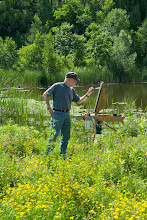
Saturday I travelled down to Bayfield, Ontario- a quaint little village tucked away on the shore of Lake Huron.
JMR Gallery was having it's annual Plein Air Day for all plein air painters
JMR is a wonderful gallery and Judy Roth is a huge supporter of Plein Air and has themed days all summer. Check out her site for more info.
What an amazing little village- so much to paint. Rambling old Victorian summer cottages perched on cliff tops. Quiet tree lined streets and a main street that is like Niagara on the Lake without the art directed 'Disney' feel.
I went down to the shore where it was blowing a 50 knot gale at least- but I huddled near the dunes and did a 12x12 oil called 'Windblown- Huron Shore' that I entered in JMR's 'Square Foot' show coming up July 8.
I'm going back next week to do an entry piece for her upcoming ' Loving Bayfield' Show that opens July 22.It's open to all painters as long as it's the Bayfield area obviously.
And it's just an hour from me in Stratford!





